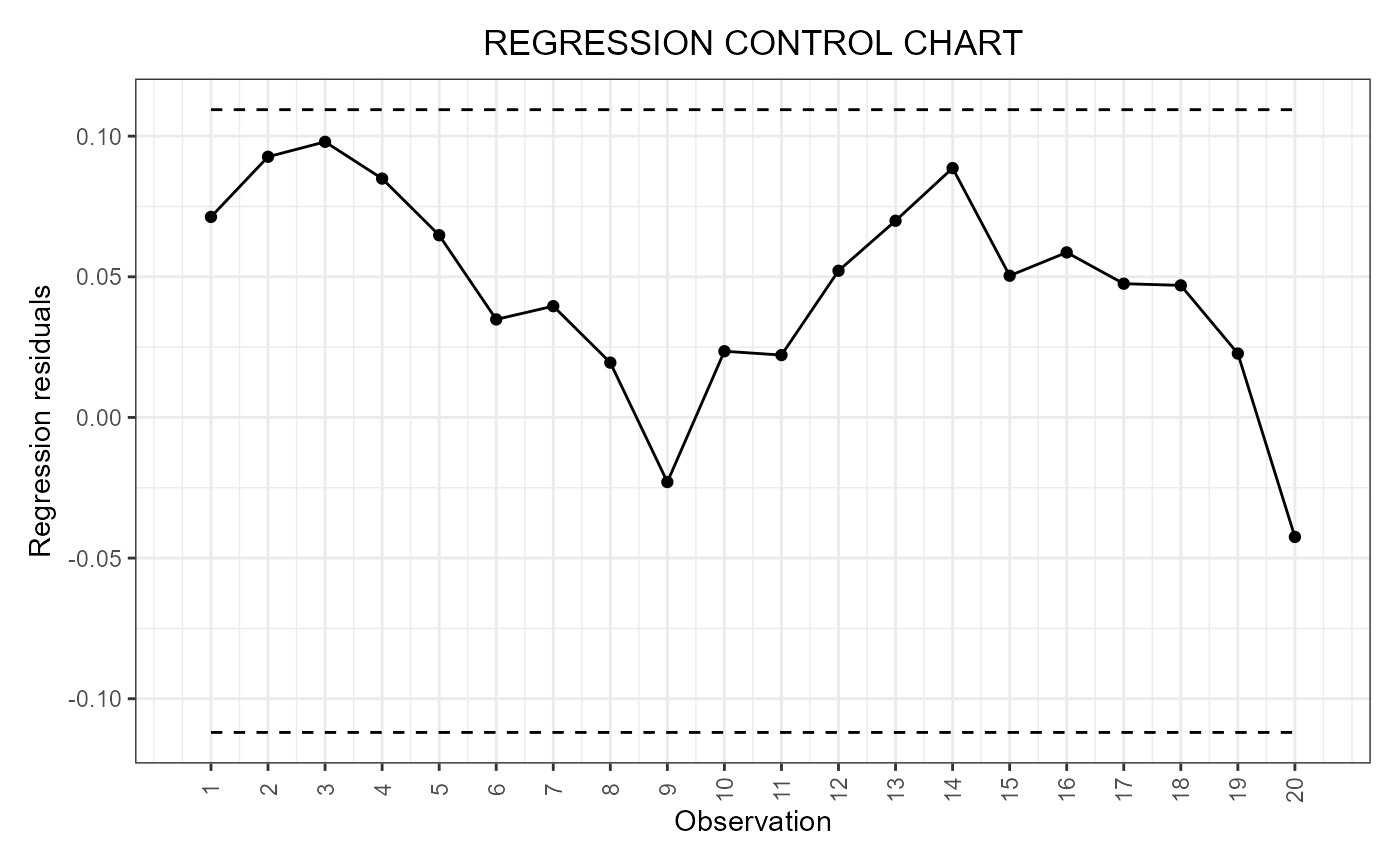This function is deprecated. Use regr_cc_sof.
This function builds a data frame needed
to plot the scalar-on-function regression control chart,
based on a fitted function-on-function linear regression model and
proposed in Capezza et al. (2020).
If include_covariates is TRUE,
it also plots the Hotelling's T2 and
squared prediction error control charts built on the
multivariate functional covariates.
regr_cc_sof(
object,
y_new,
mfdobj_x_new,
y_tuning = NULL,
mfdobj_x_tuning = NULL,
alpha = 0.05,
parametric_limits = FALSE,
include_covariates = FALSE,
absolute_error = FALSE
)Arguments
- object
A list obtained as output from
sof_pc, i.e. a fitted scalar-on-function linear regression model.- y_new
A numeric vector containing the observations of the scalar response variable in the phase II data set.
- mfdobj_x_new
An object of class
mfdcontaining the phase II data set of the functional covariates observations.- y_tuning
A numeric vector containing the observations of the scalar response variable in the tuning data set. If NULL, the training data, i.e. the data used to fit the scalar-on-function regression model, are also used as the tuning data set. Default is NULL.
- mfdobj_x_tuning
An object of class
mfdcontaining the tuning set of the multivariate functional data, used to estimate the control chart limits. If NULL, the training data, i.e. the data used to fit the scalar-on-function regression model, are also used as the tuning data set. Default is NULL.- alpha
If it is a number between 0 and 1, it defines the overall type-I error probability. If
include_covariatesisTRUE, i.e., also the Hotelling's T2 and SPE control charts are built on the functional covariates, then the Bonferroni correction is applied by setting the type-I error probability in the three control charts equal toalpha/3. In this last case, if you want to set manually the Type-I error probabilities, then the argumentalphamust be a named list with three elements, namedT2,speandy, respectively, each containing the desired Type I error probability of the corresponding control chart, whereyrefers to the regression control chart. Default value is 0.05.- parametric_limits
If
TRUE, the limits are calculated based on the normal distribution assumption on the response variable, as in Capezza et al. (2020). IfFALSE, the limits are calculated nonparametrically as empirical quantiles of the distribution of the residuals calculated on the tuning data set. The default value isFALSE.- include_covariates
If TRUE, also functional covariates are monitored through
control_charts_pca,. If FALSE, only the scalar response, conditionally on the covariates, is monitored.- absolute_error
A logical value that, if
include_covariatesis TRUE, is passed tocontrol_charts_pca.
Value
A data.frame with as many rows as the
number of functional replications in mfdobj_x_new,
with the following columns:
* y_hat: the predictions of the response variable
corresponding to mfdobj_x_new,
* y: the same as the argument y_new given as input
to this function,
* lwr: lower limit of the 1-alpha prediction interval
on the response,
* pred_err: prediction error calculated as y-y_hat,
* pred_err_sup: upper limit of the 1-alpha prediction interval
on the prediction error,
* pred_err_inf: lower limit of the 1-alpha prediction interval
on the prediction error.
Details
The training data have already been used to fit the model. An additional tuning data set can be provided that is used to estimate the control chart limits. A phase II data set contains the observations to be monitored with the built control charts.
References
Capezza C, Lepore A, Menafoglio A, Palumbo B, Vantini S. (2020) Control charts for monitoring ship operating conditions and CO2 emissions based on scalar-on-function regression. Applied Stochastic Models in Business and Industry, 36(3):477--500. <doi:10.1002/asmb.2507>
Examples
library(funcharts)
air <- lapply(air, function(x) x[1:100, , drop = FALSE])
fun_covariates <- c("CO", "temperature")
mfdobj_x <- get_mfd_list(air[fun_covariates],
n_basis = 15,
lambda = 1e-2)
y <- rowMeans(air$NO2)
y1 <- y[1:80]
y2 <- y[81:100]
mfdobj_x1 <- mfdobj_x[1:80]
mfdobj_x2 <- mfdobj_x[81:100]
mod <- sof_pc(y1, mfdobj_x1)
cclist <- regr_cc_sof(object = mod,
y_new = y2,
mfdobj_x_new = mfdobj_x2)
plot_control_charts(cclist)
